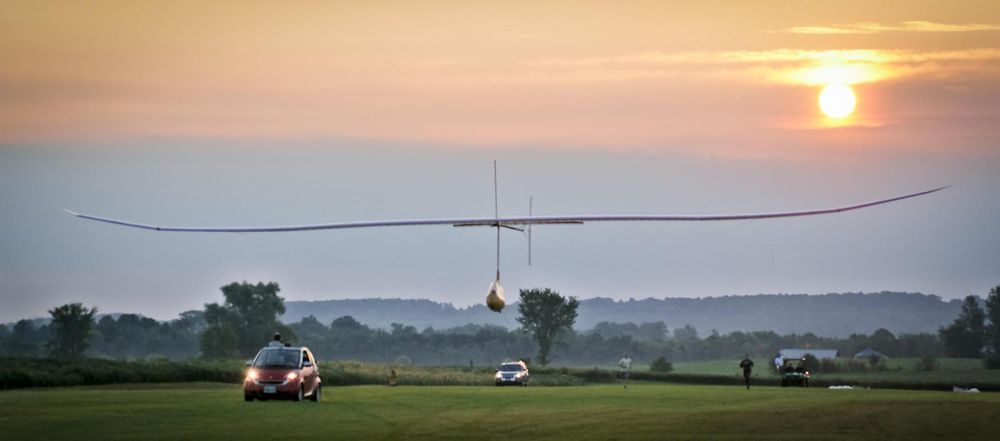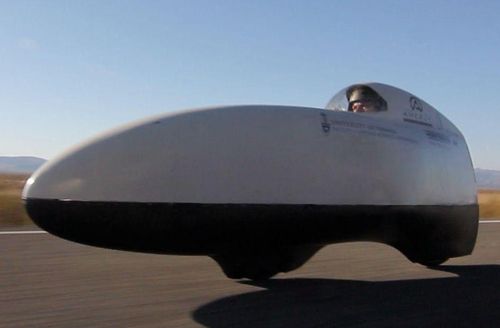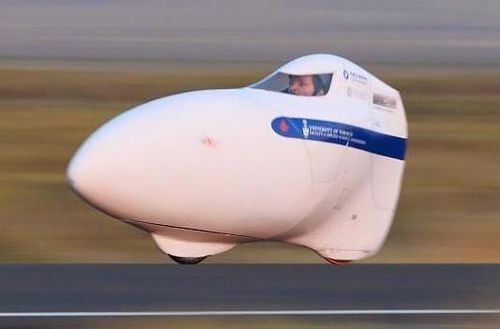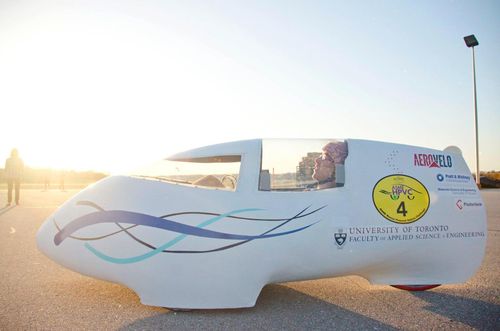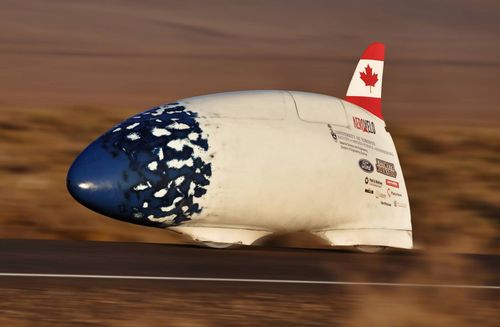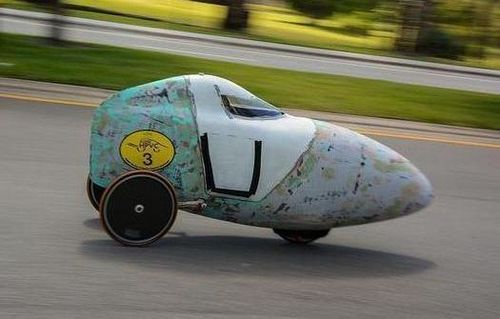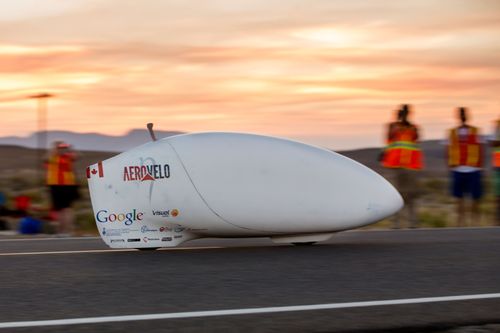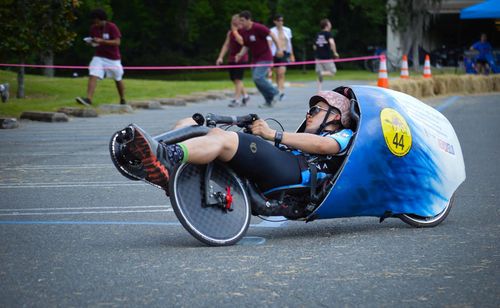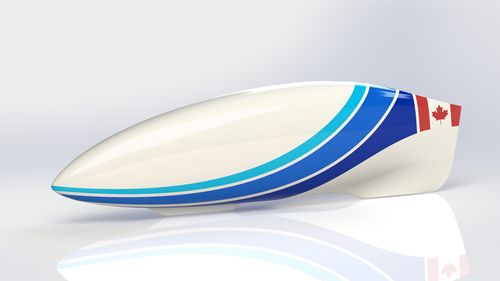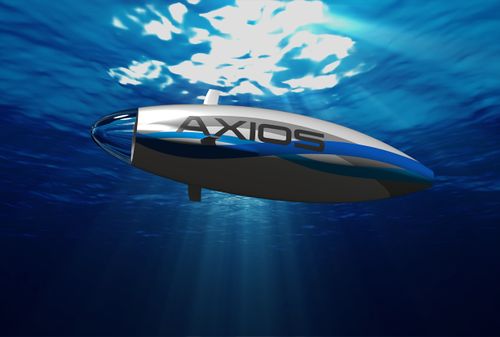University of Toronto Human Powered Vehicle
The University of Toronto Human Powered Vehicle Design Team (HPVDT) is a design team focused around designing and building vehicles solely propelled by human power. The team's past and current projects include an ornithopter, a helicopter, an airplane, a submarine, as well as numerous land vehicles.
Human Powered Ornithopter (2008)
During the summer of 2008 a group of graduate students founded the club to design and build an ornithopter (wing-flapping aircraft) that used human power alone. The project was headed by Todd Reichert (NΨ 0T4 + Film) and Cameron Robertson (NΨ 0T8). The ornithopter was successfully completed and made a record setting flight as the first human powered ornithopter.
Land Vehicles
After completing the ornithopter, the team moved onto their next project, breaking the world speed record for land single-rider cycling.
2008 - 2009
No vehicle was successfully built except for a carbon fibre frame which went on to become a training vehicle.
2009 - 2010
The team built and competed with ACE. The team competed at the ASME Human Powered Vehicle Challenge and at Battle Mountain's Human Powered Speed Challenge. ACE's top speed was approximately 100 km/h. The team scored second in both men and women sprint events, as well as third place overall in the Speed Class at the ASME event, a great performance for a new team. Furthermore, the team scored the collegiate speed record at the Battle Mountain event, with a 103km/h run. This was the first year undergraduate students were a part of the team. ACE used an aluminum frame supported in a fairing constructed from Kevlar and carbon fibre. It's total length was approximately 9 ft.
2010 - 2011
Taking what they learned in previous years, Vortex was built. Vortex was superior to ACE in many ways: it boasted superior aerodynamics, simpler front wheel fairing, a removable drive-train mechanism and used a door rather than a split dividing the top from the bottom. It was also much smaller with a length of approximately 7 ft.
The team took Vortex to compete in the ASME HPVC, this year on the Indianapolis speedway. The team placed 1st in women's sprint, 2nd in men's sprint, 1st in endurance, 6th in utility and 3rd in design. The team was awarded 1st overall in the competition.
In September of 2011 the team competed in the Battle Mountain WHPSC again, this time in hopes of setting a world speed record. After a week of racing the team marked a top speed of 116.9 km/h by Todd Reichert, still well short of the world record.
2011 - 2012
HPVDT significantly redesigned all aspects of the design for the next iteration of speedbike. Led by co-captains Trefor Evans (NΨ 1T3) and Aidan Muller (MSE 1T3), the team proceeded to manufacture the Bluenose vehicle. This design boasted much-improved aerodynamics, highly-durable construction, revised steering geometry, and a new landing gear system.
Bluenose competed at the 2012 ASME HPVC, where it won awards in the Design and Sprint events. The team finished 4th overall.
During the summer of 2012, the core membership of HPVDT was recruited to the newly-formed AeroVelo Inc. design team. The group relocated to Tottenham, ON, where they designed and manufactured the Atlas human-powered helicopter until September.
WHPSC 2012 was disappointing. A variety of handling and visibility problems prevented Bluenose from reaching its potential, and the team failed to improve upon Vortex's top speed.
2012 - 2013
Knowing that Bluenose could be greatly improved for future high-speed events, the team decided to take a different approach for the more utility-oriented ASME event. A faired tricycle was designed, using many of the same structural features as the previous two-wheeled vehicles. This new vehicle - dubbed Celero - was slower, but far more stable and reliable than the team's previous entries.
Despite mediocre performance in the Design and Innovation categories, Celero placed well in both the Sprint and Endurance races. In fact, the Endurance race was won by an unusually-large margin; Celero finished the 2.5 hour event having covered nearly 20% more distance than the next-fastest vehicle. Overall, HPVDT finished 3rd in this competition. Shortly after this event, Calvin Moes (NΨ 1T3+PEY) was elected as the new Team Captain. Long may he rule!
Collaboration with AeroVelo on the human-powered helicopter continued through 2013 until that project achieved its goal of winning the coveted Sikorsky Prize in June. Following that success, HPVDT continued to collaborate with members of AeroVelo to revise certain aspect of the Bluenose speedbike in preparation for WHPSC 2013.
The 2013 World Human-Powered Speed Challenge remains one of HPVDT's greatest successes. With low-friction tires, a custom-built camera vision system, and four well-practiced riders, Bluenose was ready to go fast. Vortex was also tuned up for three of the team's less-experienced riders. Despite some handling problems early in the week-long event, Bluenose eventually reached a top speed of 125 km/h (alumnus rider Todd Reichert), while Calvin Moes and Trefor Evans both set collegiate records. The team finished with an unprecedented 3 riders over 75 MPH, and all seven riders set ambitious personal bests. HPVDT was presented with a one-time Innovation Award for our camera vision system, which was a vast improvement over other designs in terms of clarity, function, and reliability.
2013 - 2014
HPVDT built a leaning tricycle for the ASME HPVC event. It performed well in the Innovation and Speed events, but was mediocre in Design and Endurance. The team finished 7th overall.
During the summer of 2014, members of HPVDT collaborated with AeroVelo Inc. to design and build the Eta speedbike. With a myriad of new design features and unparalleled aerodynamic quality, Eta was a favorite among the HPV community to set a new speed record.
In order to better support the Eta project, HPVDT did not field any of its own vehicles at WHPSC 2014. Along with AeroVelo's top athlete Todd Reichert, HPVDT/AeroVelo riders Trefor Evans and Calvin Moes competed in the week of racing. Todd managed to set a personal best speed, but did not achieve the goal of a new world speed record. Following the competition, strategic differences between AeroVelo and HPVDT resulted in the two organizations ceasing large-scale collaboration. As part of this agreement, HPVDT retained the right to build a "clone" of the Eta speedbike.
2014 - 2015
Again working towards a more practical vehicle design, the team came up with a partially-faired lowracer - a recumbent bike with very little frontal area. The design included several novel features, including an ill-fated carbon leaf spring suspension system.
The 2015 ASME competition was a mixed experience. The new Viteza design proved less versatile than expected, and the suspension system introduced unanticipated instabilities. Regardless, the team scored well in Innovation and won 1st place in the Design event.
During the summer term, several members of HPVDT undertook to construct an updated version of the Eta speedbike, to be called Eta Prime. While not completed in time for WHPSC 2015, the new speedbike project made excellent progress. Among the modifications made were a lighter fairing, a stiffer frame, and an updated electronics package.
Concurrently with work on the new speedbike, HPVDT undertook to design and build a human-powered submarine with the goal of smashing existing records for both speed and endurance. The project began with a feasibility study followed by extensive research into hydrodynamics, SCUBA technology, and safety systems. By the end of 2015, all major design decisions had been made and work was progressing towards finalization of the hydrodynamic shape.
2015 - 2016
While continuing work on Axios and Eta Prime, HPVDT designed an improved version of Vortex called Cyclone. Cyclone features a more sophisticated drivetrain structure, retractable landing gear for low speed stability, and improved composites techniques, resulting in a lighter vehicle. The vehicle was not completed in time for ASME 2016, but was completed and raced at the Northbrook Velodrome in July of that year. The vehicle suffered from poor drivetrain reliability and insufficiently stiff landing legs.
Through the summer, work on Eta prime was completed and the team raced it for the first time at WHPSC 2016. At the same event, former team founder Todd Reichert set a new absolute world record of 144.17 km/h (89.59 mi/h) in Eta.
2016 - 2017
Evan Bennewies and Alan Pettit led the ASME project to build another iteration of Vortex called Tempest. It refines the concept of Cyclone explored the previous year, featuring reinforced landing legs, a quick release drivetrain assembly, and compatibility with the very fast Michelin blue eco-marathon tires. The vehicle competed at ASME HPVC 2016, and was thereafter used at HPRA races and for training new riders. Though the vehicle improved upon the reliability of Cyclone, it never reached the same consistency as Vortex.
The team refines Eta prime over the summer and gets it in good working order while Calvin familiarizes himself with its handling. The team also restores Bluenose and sends both vehicles to Battle Moutain. At WHPSC 2017, Calvin reaches a maximum speed of 127.62 km/h (79.30 mi/h), the highest speed of the competition. Most of the other team members in attendance also each attain personal bests.
2017 - 2018
The team pursues a fully faired recumbent tricycle with external wheel pods called Arbiter for ASME under project director Bruce Hu. The design features a tadpole configuration with two external front wheels with co-moving wheel fairings, steered by a four bar linkage. For the first time in team history, the vehicle is test ridden before the competition. Unfortunately, the vehicle suffered a mechanical malfunction in the right steering rod during the first heat of the Women's drag event and the damage prevents the team from competing in either drag event. However the team works through the night and the vehicle is once again functional the next morning and finishes the endurance event in 4th place.
In May, Calvin resigns as captain and Bill Kong replaces him. For World Speed Challenge the team sends Eta Prime and Bluenose again where Calvin finally earns his long awaited 80 mph hat and finishes the competition in second place overall.
2018 - 2019
For ASME, the team builds the partially faired upright bike Zephyr. The design features front and rear fairings inline with the rider's torso, significant use of prepreg carbon, streamlined frame, and wheel sections, and a wide range of positional adjustment. The vehicle was again tested and ride-logged before the competition and performed smoothly throughout the event. Zephyr took first place in both Men's and Women's drag events and dominated the Endurance event, lapping the second-place vehicle seven times.
Calvin starts a new project for a two-seater speedbike, Titan. The design is similar in many ways to a scaled-up Eta prime. The vehicle is not quite finished in time to leave for WHPSC, but the team brings it along and continues to work on it when they arrive in Battle Mountain. On Friday night, September 13th, 2019, Calvin and Evan push Titan to 120.27 km/h (74.73 mi/h) and set a new world tandem record.
Current and Future Projects
For the 2019-2020 year, HPVDT will build a vehicle to compete at both ASME 2020 and WHPSC 2020 under multitrack. Several vehicle configurations are currently being considered including a diamond-configuration quadcycle and a delta tricycle.
The team is also resuming its long forestalled Axios submarine project, with the goal of finally getting it in the water by early 2020.
Titan will receive upgraded electronics, mechanical enhancements, and aerodynamic fairing before returning to WHPSC 2020.
